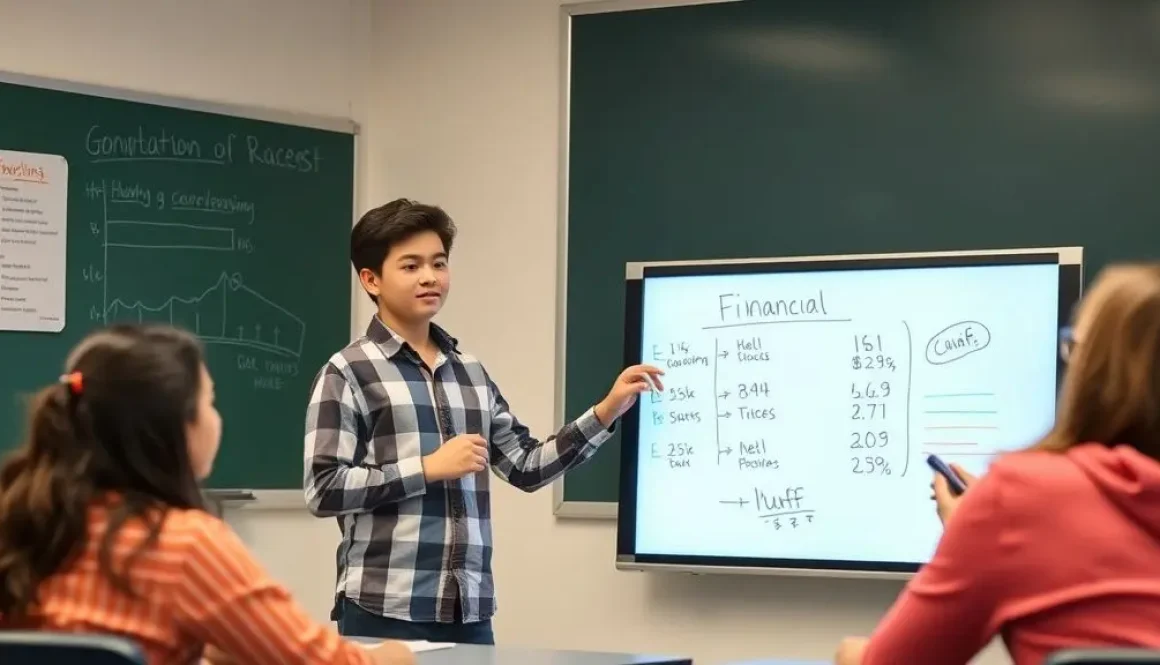Mastering Money: The Rise of Financial Literacy in U.S. High Schools in 2025
Mastering money is no longer an optional skill—it’s a necessity. In today’s complex financial landscape, understanding how to manage personal finances is crucial for young individuals preparing to enter adulthood. Recognizing this, U.S. high schools are increasingly integrating financial literacy into their curricula, aiming to equip students with the knowledge and skills needed for financial well-being.
Mastering money is no longer an optional skill—it’s a necessity. In today’s complex financial landscape, understanding how to manage personal finances is crucial for young individuals preparing to enter adulthood. Recognizing this, U.S. high schools are increasingly integrating financial literacy into their curricula, aiming to equip students with the knowledge and skills needed for financial well-being.
This shift reflects growing awareness among educators, policymakers, and parents that financial literacy is foundational to success in adult life. With the rising costs of college education, the increasing use of credit cards among teenagers, and the ever-changing dynamics of the job market, young people are often thrust into financial independence with little to no preparation. The result? Many fall into debt traps, make poor investment decisions, or struggle with basic budgeting. High school financial education seeks to prevent this by providing students with tools to make smart decisions early on—before the consequences of mismanagement become life-altering.
Incorporating financial literacy into the classroom involves more than just teaching students how to balance a checkbook. Today’s programs are much more comprehensive. Students are introduced to topics such as understanding interest rates, managing credit scores, investing in stocks and mutual funds, deciphering insurance policies, and preparing for taxes. Through interactive modules, case studies, and real-world simulations, students learn how financial decisions affect their long-term goals, from buying a car or a house to planning for retirement.

The results have been promising. Studies show that students who receive financial education in high school are more likely to save regularly, budget effectively, and avoid high-interest debt. According to the Council for Economic Education, students in states with guaranteed financial literacy requirements perform better in managing money after graduation compared to their peers in states without such mandates. Moreover, these students display greater confidence in handling their own finances, a trait that positively correlates with responsible financial behavior in adulthood.
Beyond individual benefits, there are broader societal advantages to enhancing financial literacy among youth. Financially savvy citizens contribute to a healthier economy—they are less likely to default on loans, more likely to invest, and better prepared to weather economic downturns. Furthermore, educated consumers are less vulnerable to predatory lending practices and financial scams, which disproportionately affect those with limited financial understanding.
Yet, for all its benefits, implementing financial education is not without challenges. There’s a need for standardized curricula that ensure consistency across states. Many teachers lack formal training in finance and require professional development to effectively deliver the material. Additionally, schools must find space within already crowded curricula to fit these essential lessons. Despite these hurdles, the growing consensus remains: financial literacy is no longer a luxury. It’s a life skill, as vital as reading and math.
In an age where financial decisions are becoming increasingly complex—where students may graduate already burdened with student loans or be expected to navigate the gig economy—equipping the next generation with sound financial knowledge is both a moral and practical imperative. As financial literacy becomes embedded in the educational framework, the future looks brighter for students who will graduate not only with academic knowledge, but with the financial tools to build stable, successful lives.

The Growing Emphasis on Financial Literacy (Mastering Money)
Over the past decade, there has been a significant shift in educational priorities concerning financial education. As of 2025, 36 states have implemented some form of financial literacy education as a graduation requirement, up from 21 in 2020 . This trend reflects a growing consensus on the importance of teaching students about budgeting, saving, investing, credit, taxes, and the cost of living.
For instance, California passed legislation in June 2024 mandating that high school students complete a standalone one-semester personal finance course by the 2030–31 school year . Similarly, Rhode Island’s new graduation requirements, effective for the class of 2024, require students to demonstrate proficiency in financial literacy.
The Impact on Students
Integrating financial literacy into high school education has tangible benefits for students. Courses covering topics like budgeting, saving, and investing empower students to make informed financial decisions. Students like Theo Bosio and Lilly Campbell have applied their knowledge by opening investment accounts and seeking more scholarships.
Moreover, early exposure to financial education helps students develop healthy financial habits, reducing reliance on credit and increasing scholarship use. Teachers report high engagement levels, indicating that these lessons resonate with students as essential life skills.
Challenges and Considerations
Despite the progress, challenges remain. Some states allow financial literacy courses to substitute for core subjects like math, potentially impacting students’ postsecondary readiness . Additionally, disparities in financial literacy persist across sociodemographic groups, with women, low-income individuals, and those with lower education levels often exhibiting lower financial literacy levels.
To address these issues, it’s essential to implement comprehensive, engaging, and relevant financial literacy curricula that cater to diverse student populations. Programs should cover a wide range of topics, including budgeting, credit, debt management, investing, and saving, to ensure students are well-prepared for financial independence.
The Role of Technology and Partnerships
Technology plays a pivotal role in enhancing financial literacy education. Digital platforms and resources, such as those provided by organizations like NextGen Personal Finance and Jumpstart Coalition, support schools in delivering effective financial education . These tools offer interactive learning experiences that engage students and reinforce key financial concepts.
Furthermore, partnerships between schools and financial institutions can provide additional support. Banks can collaborate with K-12 school systems to offer financial literacy education, bringing real-world financial insights into the classroom.
The rise of financial literacy in U.S. high schools marks a significant step toward preparing students for the financial challenges of adulthood. By continuing to expand and refine financial education programs, schools can empower students to make informed financial decisions, ultimately contributing to their long-term financial well-being.

